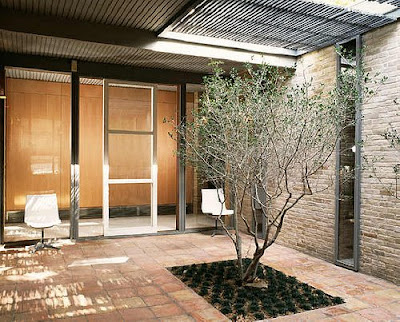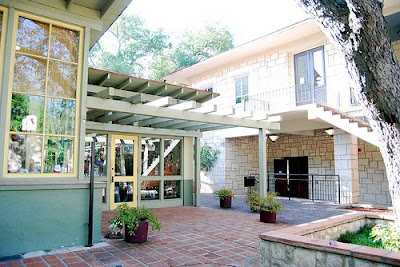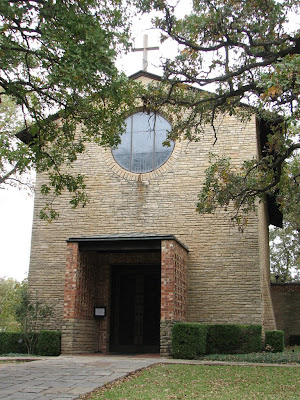 When my older brother was going to college in San Antonio, he would mention to me a particular architect that had designed much of the campus. During my visits, I found each of the buildings to be of distinctive modern design and the spaces between them intimate in scale and responsive to the steep site. My brother praised the quality of the architecture by this apparently celebrated designer, O'Neil Ford, and continues to insist to this day that it was one of the most beautiful environments he had ever lived in. I had never heard of this architect, and I would soon forget about him until a couple of years later, he had me visit a house that belonged to a family whose son he was tutoring. There was a particular crispness to the exterior sillhouette, fine detailing and an original palette of materials and finishes. Inside, the rooms were layed out along a hallway gallery, which functioned as an strong axial spine permitting uninterrupted views of a beautiful large garden beyond. Sure enough, this handsome home was an O'Neil Ford design, which thus piqued my curiosity about the man and his buildings that would endear to my continuing interest in how local and and global influences could interact in a meaningful way.
When my older brother was going to college in San Antonio, he would mention to me a particular architect that had designed much of the campus. During my visits, I found each of the buildings to be of distinctive modern design and the spaces between them intimate in scale and responsive to the steep site. My brother praised the quality of the architecture by this apparently celebrated designer, O'Neil Ford, and continues to insist to this day that it was one of the most beautiful environments he had ever lived in. I had never heard of this architect, and I would soon forget about him until a couple of years later, he had me visit a house that belonged to a family whose son he was tutoring. There was a particular crispness to the exterior sillhouette, fine detailing and an original palette of materials and finishes. Inside, the rooms were layed out along a hallway gallery, which functioned as an strong axial spine permitting uninterrupted views of a beautiful large garden beyond. Sure enough, this handsome home was an O'Neil Ford design, which thus piqued my curiosity about the man and his buildings that would endear to my continuing interest in how local and and global influences could interact in a meaningful way.Other than from admiring references mentioned by the older professors at school, it would be only until recently that I decided to become more deeply acquainted with the Texas master's work. Up to that point it was well known that he was among the most influential architects in Texas, responsible for establishing an emerging local Modernist tradition. His own firm survives under the name Ford, Powell & Carson, which still has a strong reputation in the state, even as it has relinquished trend-setting status long ago. Beyond being exponents of modern design, I became familiar with the firm's work in historic preservation upon working with their exquisite working drawings in trying to reconstruct details for a 19th-century courthouse in East Texas. At the time I had considered this as just another project specialty that countless other large firms had taken up as the market for architectural preservation was expanding. It did not occur to me that preservation was of special significance to the founder O'Neil Ford himself in his attempts in creating an authentically Texan modern architecture.
One of the most glaring realizations upon trying to get to know the state's most cherished architect was how little was written about him. If it were not for a valuable retrospect written by David Dillon, a widely read local architecture critic and scholar, even less would be known about Ford. He designed hundreds of projects throughout the state from the 1920s all the way to the 1970s, with a client roster that would include Texas' most icon ic corporate pioneers in its trademark industries of oil, retail and microchips. He would lecture and teach at the most celebrated architecture schools, and would even serve on arts commissions under president Lyndon Johnson. San Antonio's skyline would be indistiguishable without its 750 foot tall Tower of the Americas, which Ford designed as part of the 1968 World's Fair. Great swaths of historic building fabric that help make San Antonio the most picturesque city in the state were preserved by Ford's important advocacy. He introduced innovative structural systems to buildings, exploring the possibilities of thin-shell concrete and paraboloid roofs for industrial and civic buildings, including some of the most elegant laboratories for Texas Instruments.
ic corporate pioneers in its trademark industries of oil, retail and microchips. He would lecture and teach at the most celebrated architecture schools, and would even serve on arts commissions under president Lyndon Johnson. San Antonio's skyline would be indistiguishable without its 750 foot tall Tower of the Americas, which Ford designed as part of the 1968 World's Fair. Great swaths of historic building fabric that help make San Antonio the most picturesque city in the state were preserved by Ford's important advocacy. He introduced innovative structural systems to buildings, exploring the possibilities of thin-shell concrete and paraboloid roofs for industrial and civic buildings, including some of the most elegant laboratories for Texas Instruments.
 ic corporate pioneers in its trademark industries of oil, retail and microchips. He would lecture and teach at the most celebrated architecture schools, and would even serve on arts commissions under president Lyndon Johnson. San Antonio's skyline would be indistiguishable without its 750 foot tall Tower of the Americas, which Ford designed as part of the 1968 World's Fair. Great swaths of historic building fabric that help make San Antonio the most picturesque city in the state were preserved by Ford's important advocacy. He introduced innovative structural systems to buildings, exploring the possibilities of thin-shell concrete and paraboloid roofs for industrial and civic buildings, including some of the most elegant laboratories for Texas Instruments.
ic corporate pioneers in its trademark industries of oil, retail and microchips. He would lecture and teach at the most celebrated architecture schools, and would even serve on arts commissions under president Lyndon Johnson. San Antonio's skyline would be indistiguishable without its 750 foot tall Tower of the Americas, which Ford designed as part of the 1968 World's Fair. Great swaths of historic building fabric that help make San Antonio the most picturesque city in the state were preserved by Ford's important advocacy. He introduced innovative structural systems to buildings, exploring the possibilities of thin-shell concrete and paraboloid roofs for industrial and civic buildings, including some of the most elegant laboratories for Texas Instruments.Beyond these notable accomplishments is the extent of Ford's influence on younger designers that would later shape the contemporary architectural landscape unique to Texas. The names of the interns that came and went at Ford's San Antonio studio serves as veritable "Who's who" of founders of major firms, deans at the major achitecture schools and signature local architects who would make their mark designing exquisite home for the moneyed local elite. Despite never having gone to architecture school, much less to college, he cultivated deep links with art and design professors at universities throughout the state and felt quite at home in a cultural salon setting with his artist friends. The almost bohemian way in which young designers would show up at his doorstep and agree to work for little to no wage in exchange for a small room near the studio eerily parallels the cult-like encampment at Frank Lloyd Wright's Taliesin compound in Arizona. Like Wright, Ford championed the importance of incorporating traditional crafts in his spaces, especially in the houses he designed, enlisting his brother, a master carver and sculptor, to create custom doors, screens, and louvered grates. Just as Wright expounded at length on the nature of materials and proper ways to use them, Ford demonstrated similar sensitivity, taking into account the climate, local availability and vernacular tradition. He detested the superficial treatment of the wall, joking that most brick veneer walls were "brick venereal." He would eventually develop his own vocabulary of materials that would later come to exemplify Modernism in Central Texas: massive masonry walls, either of stone or of pink brick, metal standing seam roofs with severely thin edges at the eave, floor to ceiling-glass, deep porches and simplified volumes that echo the pioneer sheds of the first settlements in the region.
Even as Ford helped usher a modern architectural idiom for Texas, he was a deeply involved in the preservation of its heritage. One of his earliest major undertakings was in the revitalization of the historic neighborhood of La Villita in downtown San Antonio during a time when the practice of historic preservation was unheard of. This ecclectic agglomeration of blocks built by Mexican and European settlers in throughout the 19th century just along the south bank of the San Antonio river was re-adapted into an arts and crafts colony and complements the rustic charm of the city's main tourist attraction, the Riverwalk. In contrast to other preservation projects at the time (late 1930s) that tended to make living museums out of entire districts by isolating them from the surround contemporary economic and  cultural life (eg. Williamsburg), La Villita was to be integrated into San Antonio's cutlural life and produce artifacts that would help define the city's identity. There was little desire to recreate the look and feel of a place a specific point in time. Instead, the district would serve as an architectural panorama of the passing of time, emphasizing the evolving spirit of the diverse inhabitants and their affect on the built fabric. Ford's guiding reason for the district's redevelopment was "not archaeological-but rather attempt to preserve the spirit of architecture that is Texan".
cultural life (eg. Williamsburg), La Villita was to be integrated into San Antonio's cutlural life and produce artifacts that would help define the city's identity. There was little desire to recreate the look and feel of a place a specific point in time. Instead, the district would serve as an architectural panorama of the passing of time, emphasizing the evolving spirit of the diverse inhabitants and their affect on the built fabric. Ford's guiding reason for the district's redevelopment was "not archaeological-but rather attempt to preserve the spirit of architecture that is Texan".
 cultural life (eg. Williamsburg), La Villita was to be integrated into San Antonio's cutlural life and produce artifacts that would help define the city's identity. There was little desire to recreate the look and feel of a place a specific point in time. Instead, the district would serve as an architectural panorama of the passing of time, emphasizing the evolving spirit of the diverse inhabitants and their affect on the built fabric. Ford's guiding reason for the district's redevelopment was "not archaeological-but rather attempt to preserve the spirit of architecture that is Texan".
cultural life (eg. Williamsburg), La Villita was to be integrated into San Antonio's cutlural life and produce artifacts that would help define the city's identity. There was little desire to recreate the look and feel of a place a specific point in time. Instead, the district would serve as an architectural panorama of the passing of time, emphasizing the evolving spirit of the diverse inhabitants and their affect on the built fabric. Ford's guiding reason for the district's redevelopment was "not archaeological-but rather attempt to preserve the spirit of architecture that is Texan". The lesson to be drawn from Ford's achievements is in the value of acknowledging tradition as we try to create new forms for our own time. In undermining the widely accepted narrative of the Modernist movement's categoric rejection of historical reference and vernacular tradition, Ford, along with other contemporary 'critical regionalists' ( such as Alvar Aalto of Finland, one of Ford's personal favorites) used these influences as the foundation on which to design a new tradition. They did not romantically regard themselves as rebels breaking with tradition but rather as conservators who also innovated to fit the contemporary need of their times. A 'softening' of the hard straight lines and stark materials that exemplified the International Style was often the result from designers like O'Neil Ford, which endowed their works with humanity, warmth and a certain spirit that harmonizes with the surrounding landscape and the accumulation of the local culture upon it.
In surveying the buildings of O'Neil Ford, there is an emphatic response to question of who and where the inhabitants of a structure are and how they are different from everyone else. One can call this 'a sense of place' or 'authenticity', but this quality about his buildings only magnifies one of the central failings of much of Modernist movement: the ignoral of the environment in all of its cultural dimensions, the diversity in the particularities of people, its failure to belong to a place. When such links to place are missing, a Modernist building's answers to who is 'anyone' and where is 'anywhere'. This lends a certain self-centeredness to a building and often becomes regarded by a community as an offense to a harmonious environment it desires. Instead of embodying a genuine contemporary identity to a place, many Modern buildings appear to impose a threatening bland universality and reductionism. The same criticism applies to the ubiquitous practice of constructing in the mode of contrived historicism, which is just as guilty in imposing a cultural identity that is just as foreign and dishonest about the spirit of a place as any Modernist counterpart. Literally imitating another place and time (like many a New Urbanist suburban development) has the uneasy effect of answering the question of who (somebody else) and where (somewhere else).
 In either the modernist or historicist mode, there seems to be an unfortunately tragic sense of cultural confidence. We are either anybody or we are somebody else, anywhere or and somewhere else, but never are we confident enough to reflect who we really are. An architecture that celebrates place and demonstrates a connection to its passage of time is therefore an affirmative act that will ensure the survival of a people's identity in the future. O'Neil Ford, along with his other global contemporaries trying to define a regional response to Moderism, serves as a model towards generating authentic solutions to modern problems that effectively preserves an authentic identity and spirit in the face of changing times. The practice of historic preservation and adaptive reuse is also signicant in achieving a cultural confidence through time, since one should never forget who they are and where they have been. Far from being a reactionary and defensive response to progressive calls for 'change' the appreciation of tradition as it has evolved in time encourages originality, spirituality and an overall depth that is sorely lacking in much our modern world.
In either the modernist or historicist mode, there seems to be an unfortunately tragic sense of cultural confidence. We are either anybody or we are somebody else, anywhere or and somewhere else, but never are we confident enough to reflect who we really are. An architecture that celebrates place and demonstrates a connection to its passage of time is therefore an affirmative act that will ensure the survival of a people's identity in the future. O'Neil Ford, along with his other global contemporaries trying to define a regional response to Moderism, serves as a model towards generating authentic solutions to modern problems that effectively preserves an authentic identity and spirit in the face of changing times. The practice of historic preservation and adaptive reuse is also signicant in achieving a cultural confidence through time, since one should never forget who they are and where they have been. Far from being a reactionary and defensive response to progressive calls for 'change' the appreciation of tradition as it has evolved in time encourages originality, spirituality and an overall depth that is sorely lacking in much our modern world. 
No comments:
Post a Comment